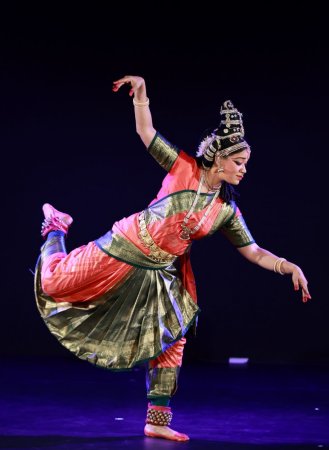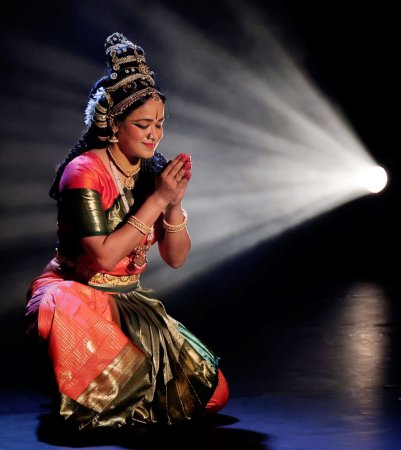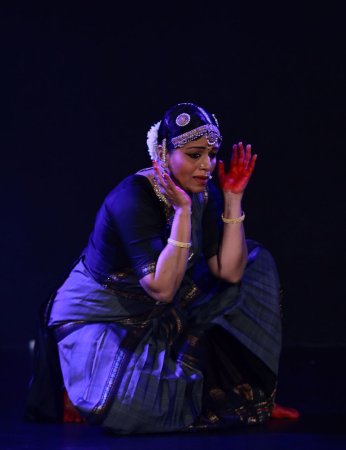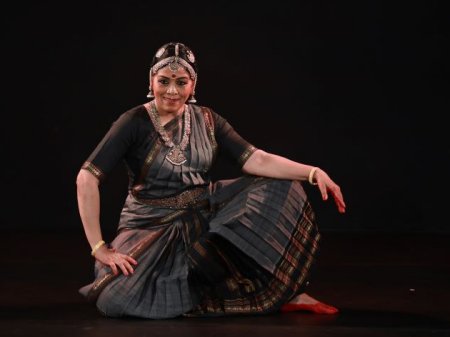
|   |

|   |
Premiere presentations at Pravaha festival of NCPA - Chandra Anand e-mail: chandra6267@yahoo.co.in January 20, 2025 NCPA held the 'Pravaha' festival, curated specially for premieres. It was held for about four days presenting at least ten presentations. In the only morning presentation of the 14th December 2024, the enthusiastic full house audience witnessed two presentations; 'Abhiramam' by Aishwarya Harish and 'Niyati Vijayita' by Revati Srinivasraghavan.  Aishwarya Harish Through 'Abhiramam', a fast-paced choreography in the Bharatanrityam style, Aishwarya Harish brought us four episodes from the Indian epic Ramayana. The idea was to portray the less explored stories culled from different versions of Ramayana, making it multilingual in approach, and selected episodes were lined up aligned to the story line of Ramayana. First one that was explored, was that of Rama's relationship with Kaushalya, from Valmiki Ramayana. Titled "Abhi-ramam," the epithet for Rama signifying beauty, Rama revealed only to Kaushalya, his original four-armed form of Mahavishnu with Shankha and Chakra when he was born, as he is born to her because of her earlier devotion to him, in her previous life. This episode was further developed with nritta and abhinaya where Kaushalya cares for baby Rama in every way required. He becomes the human child "Abhirama", the delight of his parents. Here, with verses taken mainly from Adhyatma Ramayan, music was set in the pattern of 'swara sahityam' by Dr Malladi Ravikumar. The most beautiful divine love, 'Abhi-ramya Sringaram', was brought out through verses from Tulsidas Ramayanam in Hindi language. Scenes of the first meeting of Rama and Sita and of Sita swayamvaram, were enacted with ease and aplomb where the narrative through dance moved in a smooth succession unravelling the different scenes of the episode from Sita's lifting of the Shiv Danush to retrieve the ball to solemnising of Rama's and Sita's wedding ceremony. All kings having a try to pick up the bow was fun. Ravana was described very beautifully, the sprouted appearance of his ten hands and trial taken with the bow was well delineated. The scene of first meeting between Rama and Sita was choreographed by Dr Jayashree Rajagopalan, and verses selected from Tulsi Ramayan was set to tune by Lakshmi Ramakrishnan. Arunachalakavi in the Ramanatakam, reveals how the "Abhi-ramata," the delightful beauty of Sita, enraptured even the vile Soorpanakha, that she convinces her brother Ravana to make Sita his own. Despite Shoorpanaka describing Sita's beauty, her intent to thus harm Sita by separating her from Rama was portrayed well. The strong personas of both Shoorpanaka and Ravana shone through believably.  Aishwarya Harish The next presentation had two ideas together for continuation of storyline. For Abhi-ramana Sundara Kandam, Aishwarya extolled Hanuman's feats to unite the divine couple. The song of Purandaradasa in Kannada language was used that revealed the dedication and devotion of Hanuman to Rama. Here, the feats of Hanuman at Srilanka were executed vividly to the delight of the audience. And finally, Abhi-ramaneeya Ramarajyam showed the establishment of the rule of Rama in Ayodhya. For the showcasing of the setubandhanam and Ravana Sahana scenes till pattabhishekam scenes, lyrics were written and tuned by PS Krishnamurthy in Sanskrit language. Thus, this multilingual presentation, wherein with a jugalbandi of Hindustani and Carnatic music weaved very aptly and with narratives of episodes brought forth with great attention to details with precise and apt gestures, made the presentation unique. There was great clarity in both mukhaja and angika bhava. Saushtavam was well-defined in her demeanour. Nritta, an amalgamation of Bharatanatyam, karanas of Natyasastra and desi karanas of Sangeet Ratnakara were well interwoven. Aishwarya showcased her histrionic capabilities easily transitioning from one character to another, totally immersed in each one of them. Truly an entertaining performance that delighted the audience. She was supported excellently on vocals by Harish Venkateswaran, on nattuvangam by Dr Jayashree Rajagopalan, on mridangam by Aditya Rajagopalan, on violin by Satish Sheshadri, and on sitar by Alka Gujjar.  Revathi Srinivasraghavan Revathi Srinivasraghavan presented 'Niyati Vijayita', a tale that conveys the angst of a woman. This presentation was a sensitive portrayal of Draupadi's saga in her life, right from her birth. Though her birth was a boon to the world, as destined to be a catalyst for the re-establishment of Dharma, she faced a life full of bane. Though she was part of a divine plan, she had to progress forward on her own without the comfort of knowing what lay ahead. In fact, she was a victim of a system, a mere pawn in the game of politics and war. Thus, her journey is one of intense struggles, disillusionments, and a relentless search for justice where many a lesson or moral could be learnt from her story. Revati applied an autobiographical narrative and showcased above points with veracity. The scenes were presented through gestures in lyrical lines, chollukettu and swara passages too. For nritta exposition, a trikala jathi was aptly placed after the prelude to the story line. Other short korvais interspersed between broke the tension of the story line giving out a relaxed presentation. The production began with a reference to Shiva's "adhomukha" stance (downward-facing posture), as a symbol of impending catastrophe, in this case, the Mahabharata. She is born out of yagna, performed to obtain a boon for a son who will avenge Drupad's insult by his friend. She is born as ayonija so didn't have a mother to welcome her, care for her and the delay in Drupad's reconciling to the fact of obtaining a daughter too makes her feel unwanted. She vividly enacted the scene where she bandages Krishna's wounded finger with a piece torn from her upper cloth. She has Lord Krishna for a friend and guide; perhaps it's his and her friendship that gave her the strength to go forward with her rebellion for justice. As a pawn in the revolution that had to happen she found herself in situations which were not commonly faced by normal women. She was married off to five men, though it was destined due to boon from Lord Shiva in her previous birth, the societal norms in the present society did not conform to the situation she was in. Thus she faced the disdain of her peers. The swayamvara scene presented got the rapt attention of the audience. The description of design of the yantra in which the feat to aim and pierce the eye of the fish with the bow and an arrow was to be done was depicted accurately. Arjuna's prowess in archery was well delineated. Later the shock of having to share herself with five brothers was shown with restraint and clarity of a princess. The dice scene was enacted briefly, by showing a vengeful Duryodhana asking for the game to be played, fiendish Shakuni who plays the game and lustful Dushasan who attempts to disrobe Draupadi and pitiful Draupadi who prays to Krishna and Krishna who comes as the savior. All characters were well enacted very distinctly.  Revathi Srinivasraghavan Naturally seeking justice was a priority and a need to uphold her status and dignity that came as being a princess and wife to five princes. The agony of Draupadi was well brought out. Her questions to King Dhritarashtra and her condemnation of the elders like Bhishma were the cries of a woman who has been wronged at every turn. She demands accountability from those in power, questioning not just the men who have wronged her but the very structures of authority that have allowed such injustice to unfold. After all, many rules were broken deceptively. Her journey was marked by personal loss and a lot of destruction around. The death of Abhimanyu forced Draupadi to reckon with the sheer futility of everything she had fought for. Finally, at the end of the war, she applied Dushasana's blood on her hair, portraying an expression of madness, which didn't seem to reduce the distress of her anger due to the humiliation. Which evokes a question whether she was winning or losing her rebellion, how were her experiences of insults and compromises being justified? So finally, the story of Draupadi gives an awareness - "all that glitters is not gold"; the courage to cry for justice is required when the need arises; beware, the joy of getting a positive result could be elusive. And finally the spiritual implication is God helps those who help themselves. Mortals should train their inner being and be true to themselves as they face this world. 'Niyati Vijayita' was conceptualized by Revathi Srinivasraghavan, lyrics were penned by Dr S Raghuraman, music was composed by Dr Vanathy Raghuraman, with Sathish Krishnamurthy on musical arrangement and percussions, Janani Hamsini on amazingly rendered vocals, accompanied by Radhika Devrajan on violin, Bharat Raj on flute, Manoj Pandya on side percussions and Shreya Majumder on inclusive compering. The music composed in Ragamalika was set to thisra dhruva talam, establishing the whole presentation to be an ekatala venture. And it was noted that the gatis used in the talam augmented the delineation of the swayamvaram and vastraharanam episodes, naturally applying extra credits to percussionist Sathish Krishnamurthy.  Chandra Anand is a Bharatanatyam artiste and teacher. She has an MA in Bharatanatyam from Tilak Maharashtra Vidyapeeth, and her series on 'Education in spiritual values through Bharatanatyam' is featured in narthaki.com. |